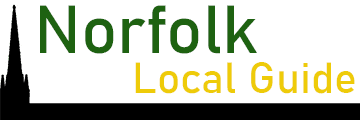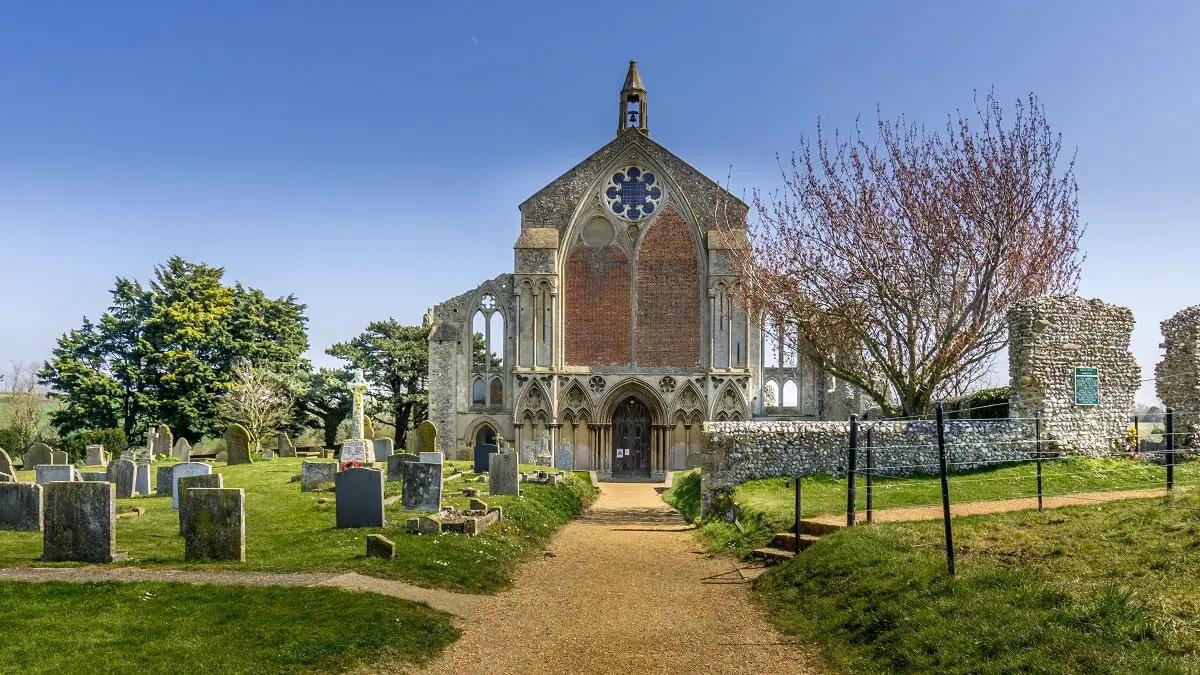Any location that has been a continuous place of worship for more than 800 years is definitely worth a visit. Binham Priory may have been closed and partially dismantled during the dissolution of the monasteries, but the nave continued on as the Binham parish church.
You’ll want to explore the ruins and go inside the parish church. Let me tell you more about the history and what to expect when you visit Binham Priory in Norfolk.
Be sure to sign up for our email newsletter here to find out about what’s happening in Norfolk.
Note: This post contains affiliate links. As an Amazon Associate, we earn from qualifying purchases. Please see disclosure for more information.
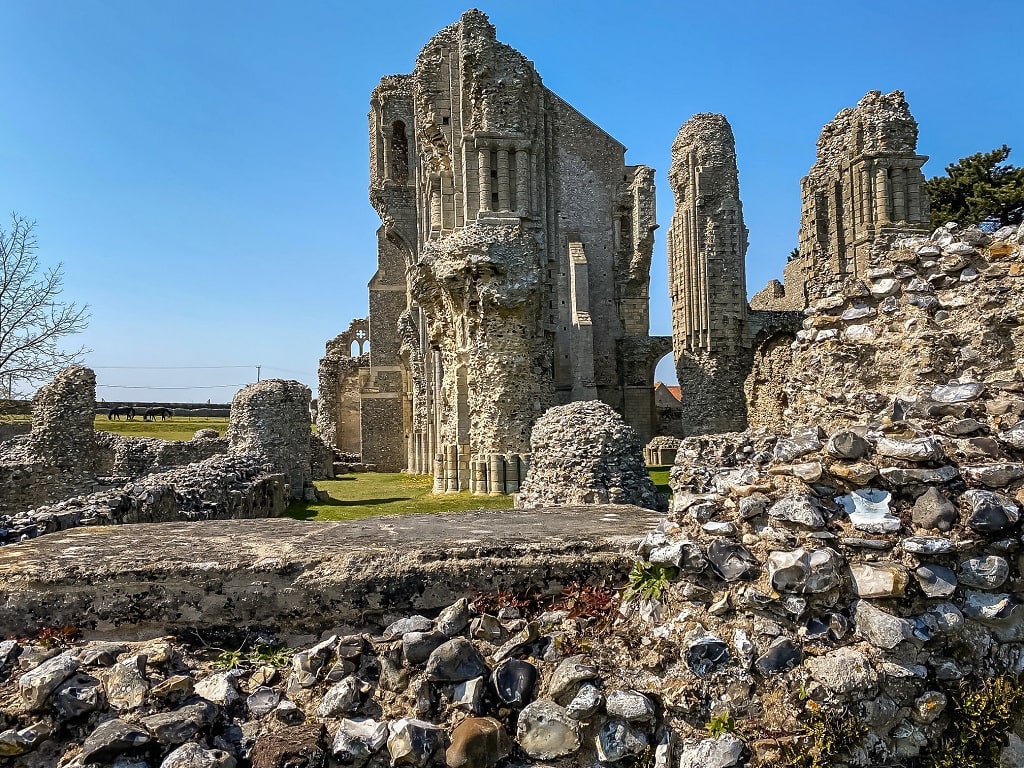
Binham Priory History
Binham Priory was founded by the nephew of William the Conqueror, Peter de Valognes Lord of Orford, and his wife, Albreda. He replaced the parish church of St. Mary, which likely would have been a small wooden building, with a new monastic church that would be a dependent house of the Benedictine Abbey of St. Albans. It took close to 150 years to build and was expanded during medieval times.
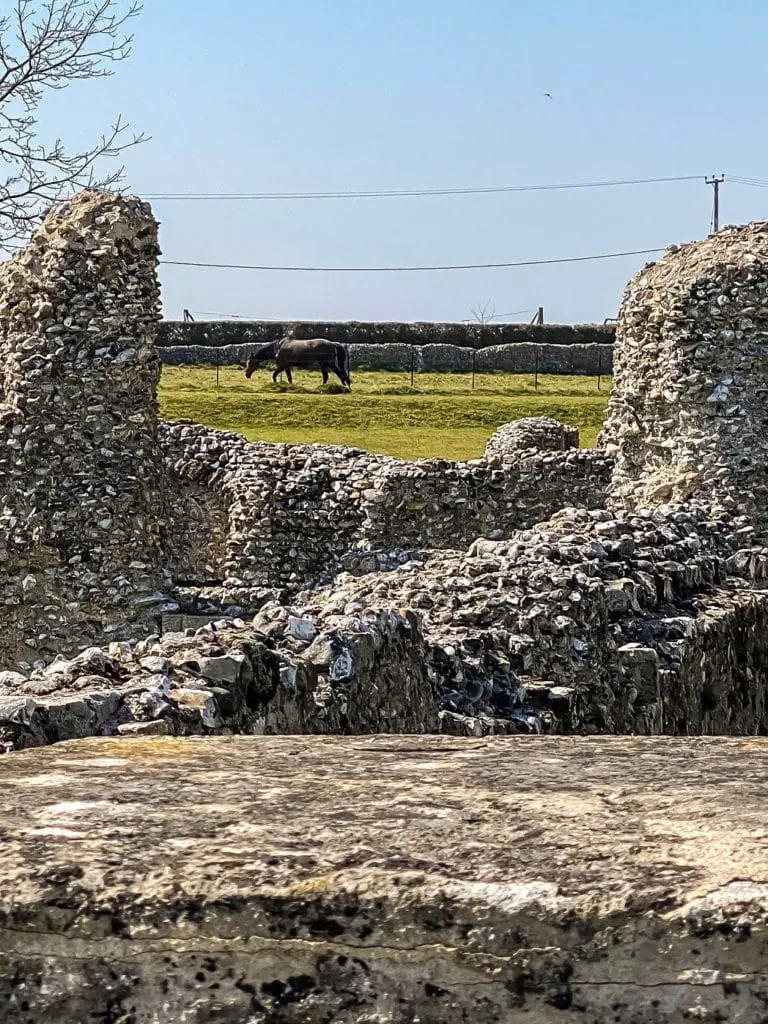
The community at Binham was always small (at most there were 14 monks and towards the end there were only six). The priory had quite a colourful history and suffered from several unscrupulous and irresponsible priors. There were also disagreements with the Abbot of St Albans Abbey, the Bishop of Norwich, and the local villagers.
Here are a few alleged examples:
- Around 1212, Robert Fitzwalter, one of the 25 barons of the Magna Carta, besieged the Priory. He was upset that the abbot of St Albans went against the priory’s charter (granted by his wife’s ancestor) by installing too many monks, taking too much revenue, and removing the prior, who was a friend of Fitzwalter. After this siege, the monks were forced to eat bran and drink water from the drain-pipes. They were saved when King John sent an armed force to help and Fitzwalter fled for his life.
- In 1317 William de Somerton became Prior of Binham. He sold many of the priory’s valuable items (two chalices, six copes, three chasubles, seven gold rings, silk cloths, silver cups and spoons and the silver cup and crown) to finance his alchemical experiments, putting the the priory in debt. King Edward I ordered the arrest of de Somerton and his 13 monks. Six of the monks ended up in prison, but de Somerton managed to escape to Rome. He eventually returned to Binham and managed to regain his position for a short time before having to run away after running up even bigger debts.
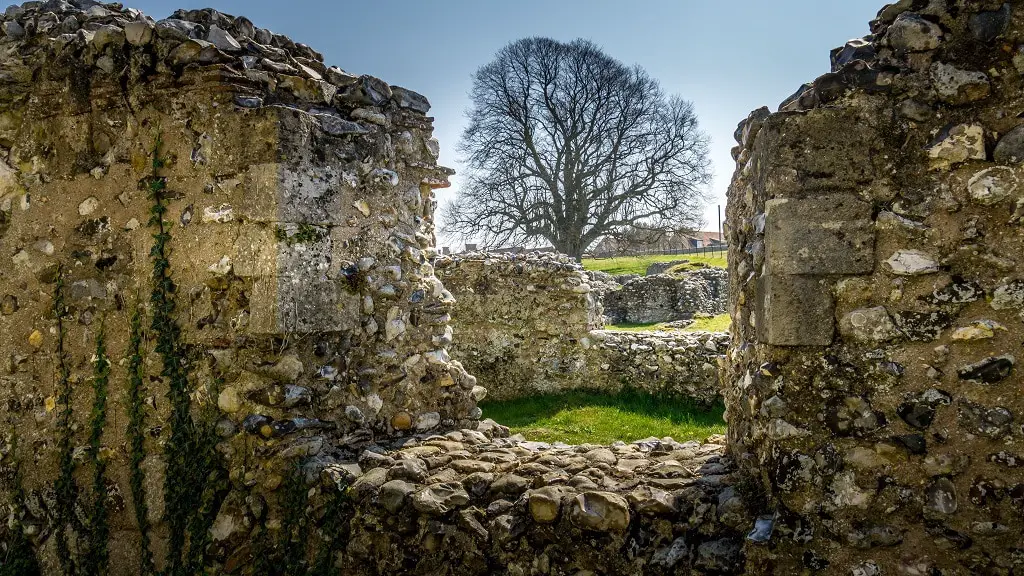
As part of the dissolution of the monasteries, the priory was closed by Henry VIII in 1539. It was sold to Sir Thomas Paston, who dismantled most of the buildings.
When Thomas Paston’s grandson, Edward, had further demolition work done to build a new house, a workman was killed by falling masonry. The project was abandoned because of this bad omen. Stone from the priory was sold and reused around the doors and windows of many houses in the village of Binham, which you can still see today.
A section of the nave continues to be used as the Binham Parish Church. It has been in continuous use as place of worship for over 800 years.
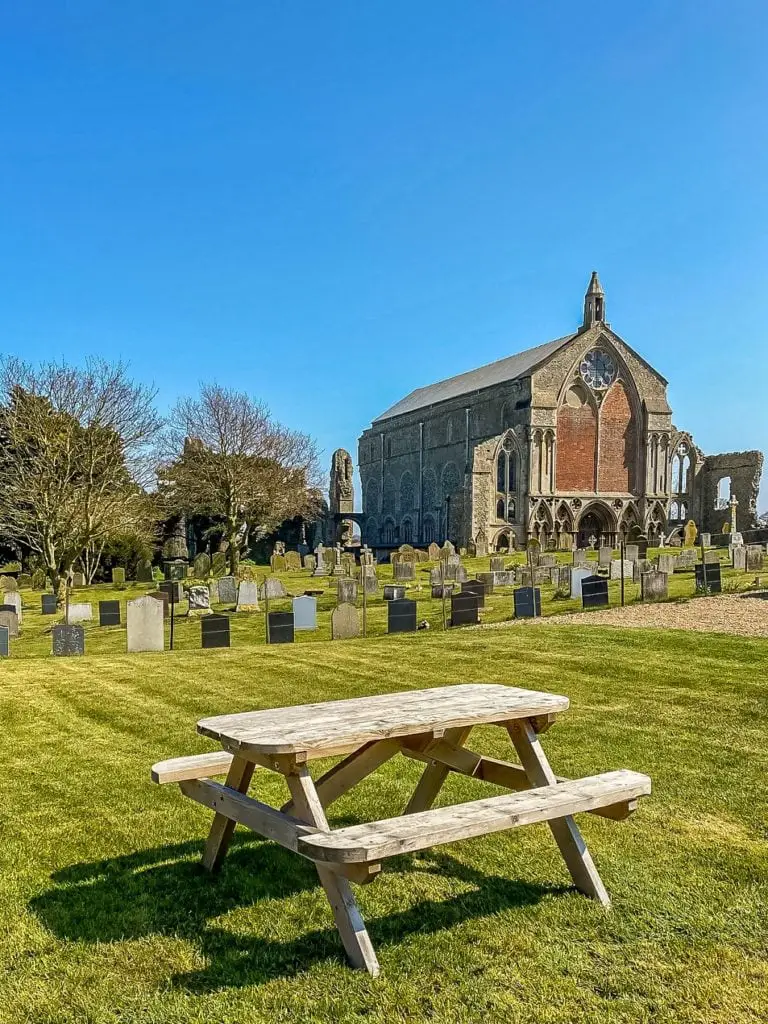
What to See at Binham Priory
You can learn more about the fascinating history of the Binham Priory and its architecture when you visit. There are information boards throughout the site so you can explore at your own pace.
Alternatively, they do offer hour-long guided tours of the Priory and its monastic precincts every Sunday and Tuesday from May to September starting at 15:00. A donation of £2 per person is requested to help maintain the priory church.
The areas to see are the gatehouse, the priory ruins (cloister and priory church), the parish church, and the priory grounds. Let me share what you will see in each one.
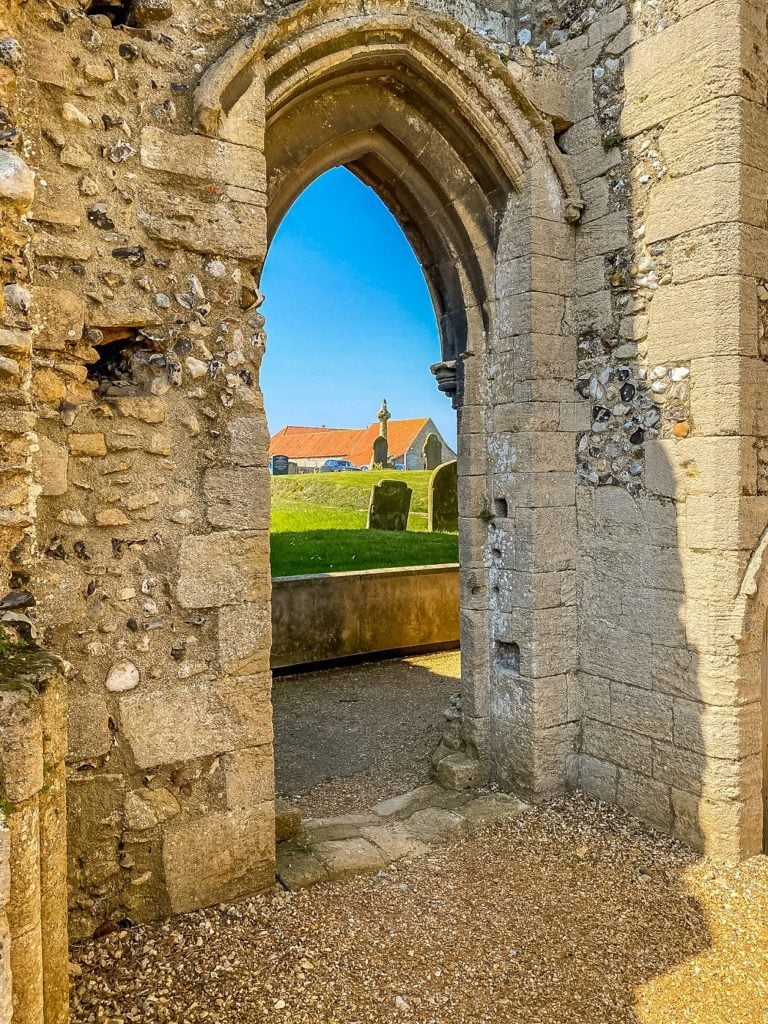
Gatehouse
To enter the car park for Binham Priory, you pass through the gatehouse which was the formal entrance to the Priory of St. Mary and its walled precinct. Wheeled vehicles and horses would have used the same entrance, while pedestrians would have used a small door on the side.
A porter would grant permission for those coming from the secular world to enter the regulated monastic world. It was the only way to get to the monastery and its other buildings. The gates would have been shut at sunset, but could be opened as needed.
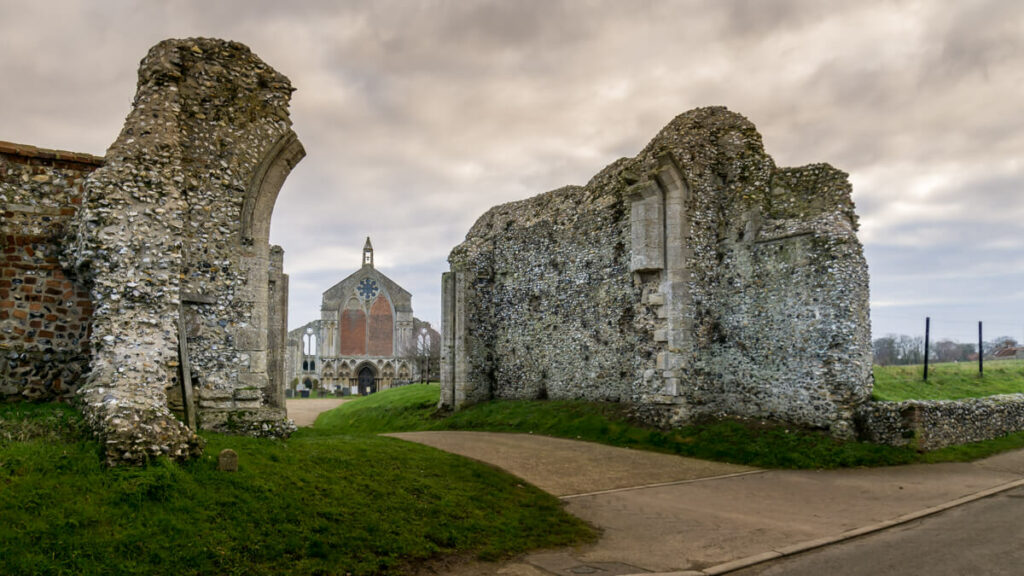
The gatehouse was built in the 1400s to impress and show the Church’s authority. It would have been decorated by exquisite stone carvings and statues of the Virgin Mary and saints. Locals nicknamed the gatehouse the Jail Gate. While no evidence was found that this gatehouse was used as a jail, other monasteries (including St. Albans Abbey) did use gatehouses for this purpose.
In the early 1900s, a “Bull House” was built inside the gatehouse. Thanks to the heritage lottery fund it was removed in 2007 along with the thick growth of ivy making it easier to see the medieval building. The metal cattle crush that was used to keep the bull from moving is still there. They would use food to lure the bull through the rails then use chains on the other side of the wall to pull them together so the bull couldn’t back out.
The Cloister
The Cloister was a garden court with covered walkways on all sides. These walkways would have given access to all the principle rooms in the Priory like the Refectory (dining room), Chapter House, Parlour, and Dormitory. The Cloister were rebuilt several times during the life of the Priory. When the Priory was closed, they moved the large windows from the Cloister to the Nave wall.
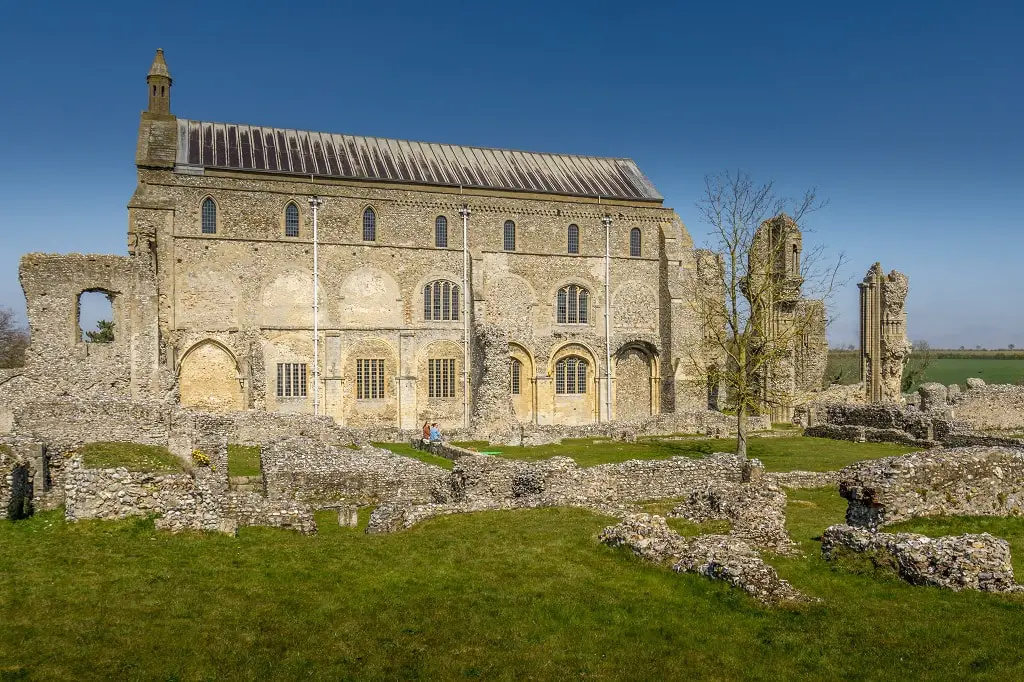
The monks would have spent time in the Cloister reading, studying, and copying manuscripts in silence. Since this was a Benedictine house, they followed a strict routine of work, prayer, study, and sleep. The only time they were allowed to talk was to discuss business of the community in the Chapter House or Parlour.
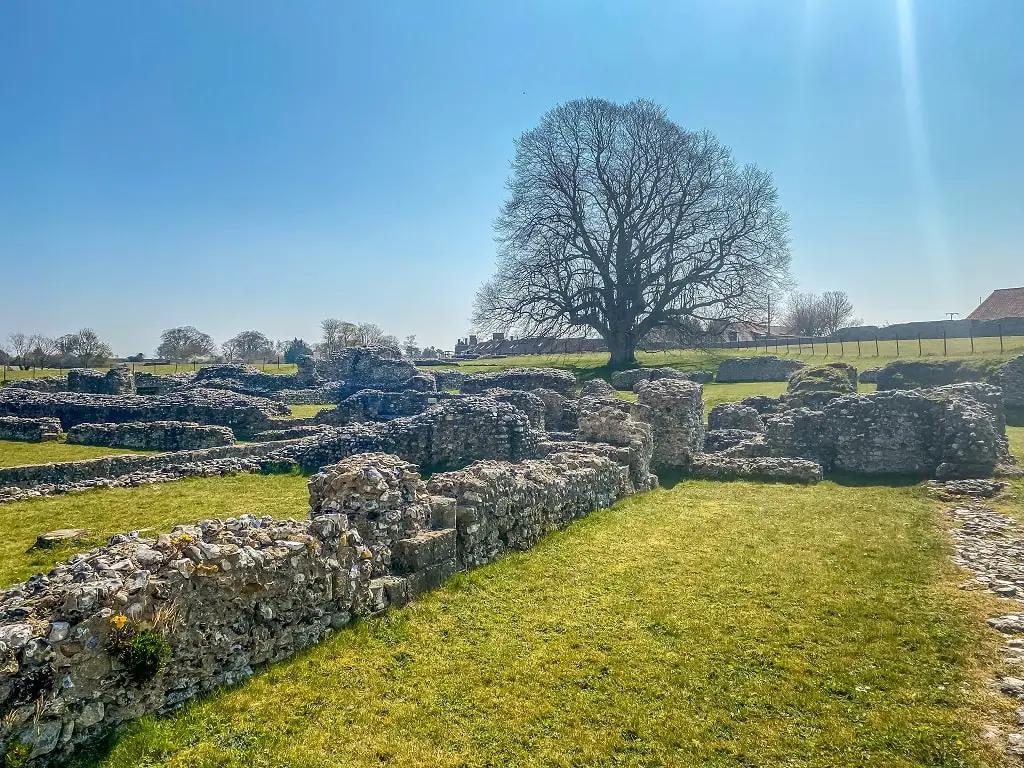
Walking through this area today is kind of like figuring out an ancient maze. You will need to be careful as there are some areas with steep drops. See if you can find the lava which was where the monks would wash their hands before eating (hint: it is marked with a sign). When we visited, we also saw people enjoying a picnic in the grassy area.
Priory Church
The Priory Church is where the monks would attend Mass and eight other services over the course of 24 hours. The monks would sit in wooden choir stalls facing each other in the area under the crossing tower. This area was separated from the public nave by a stone screen.
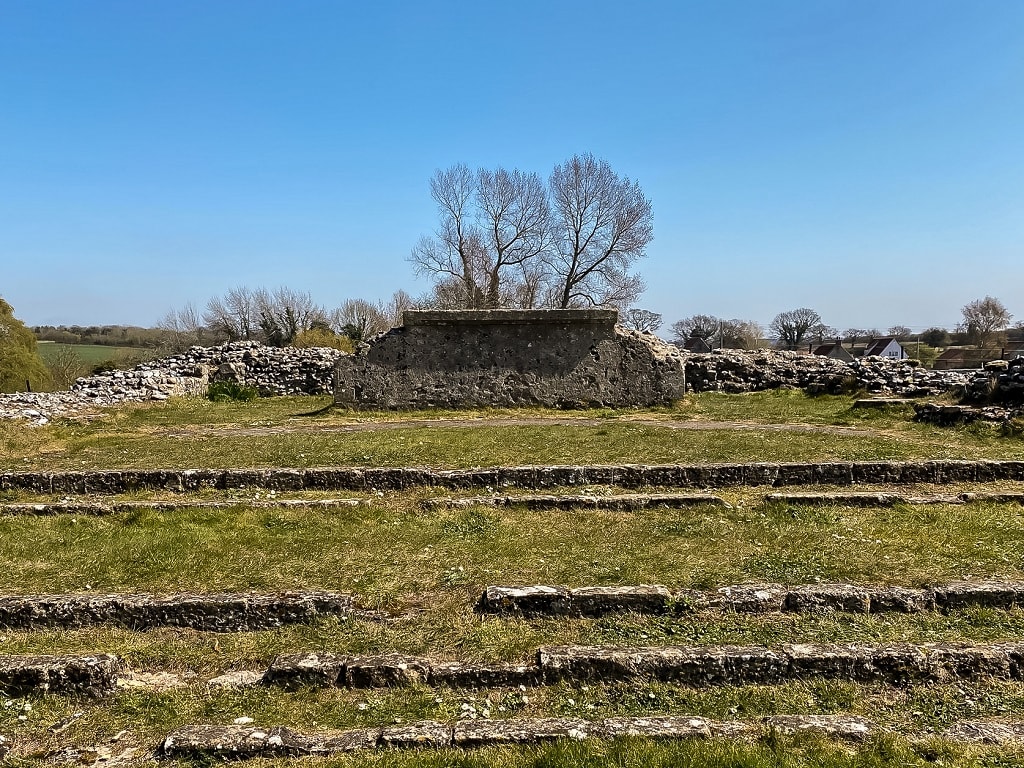
Standing in this area, you can get a feeling of how magnificent the church must have been. You can also see some remains from the high altar. Also note how you can see that the presbytery had a semicircular apse at the east end.
Parish Church
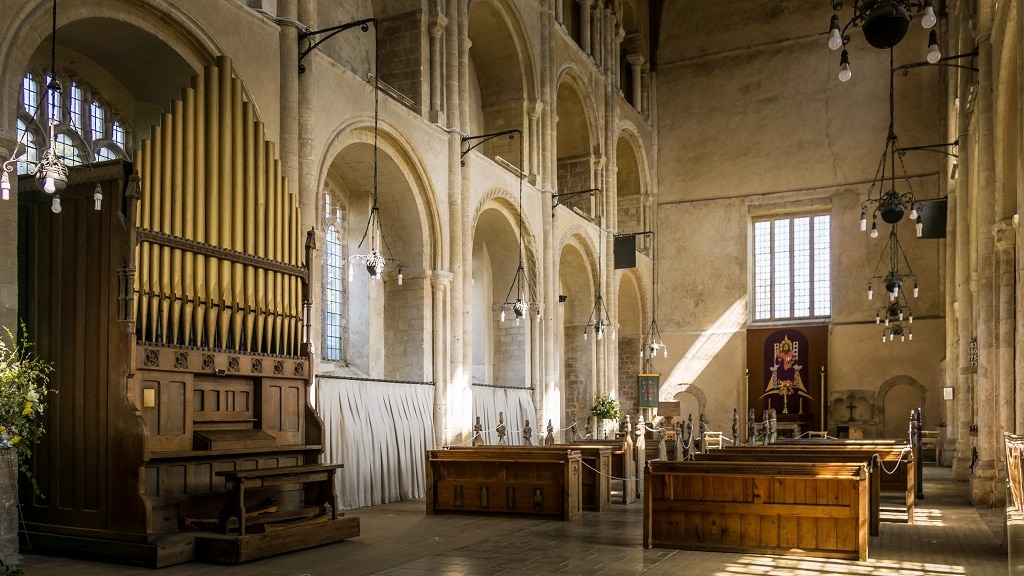
What was once the nave of the Priory Church is now the Parish Church of Binham, the Church of St Mary and the Holy Cross.
If the church is open during your visit, it’s definitely worth taking a look inside. You can see:
Rood Screen – You can see the surviving dado panels from what would have been a large structure used to divide the chancel and the nave of the church. It was believed to have been painted around 1500 as it had a painting of Henry VI. The screen was whitewashed and text from Cranmer’s Bible was written over it. Over the years the whitewash has started to come off and the figures have started to show through.
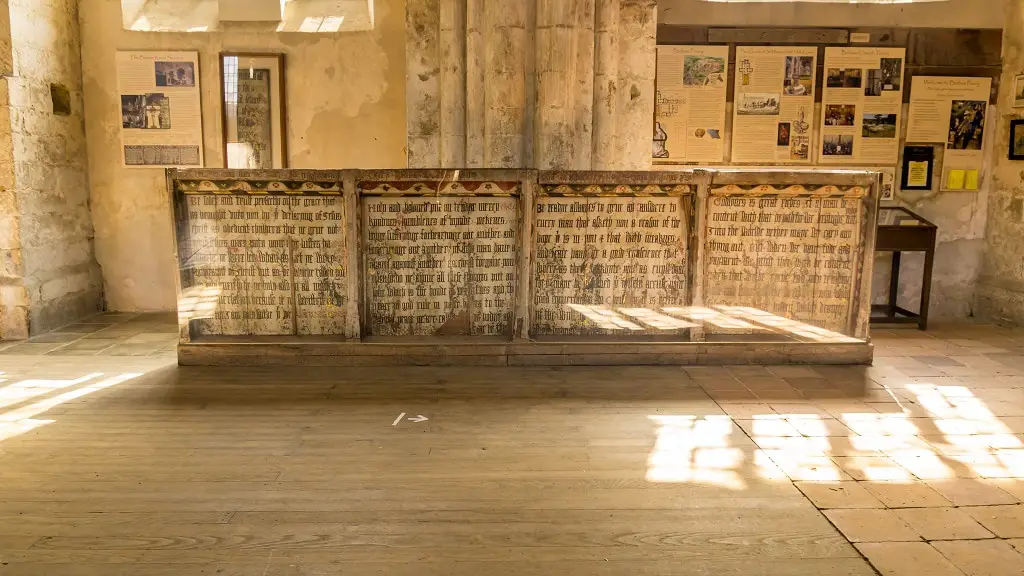
West Window – This is the earliest surviving example of “Bar Tracery” in England where carved stone is designed to form a complex pattern of arches and braces within the main arch. It was built in 1227-44 and started to fail in the 1700s. The window was blocked in 1809 to strengthen it.
Font – It’s a 15th-century East Anglian Seven Sacrament Font. If you look closely, you can see some colour in the deepest folds. There is a representation of what the font would have looked like on the wall.
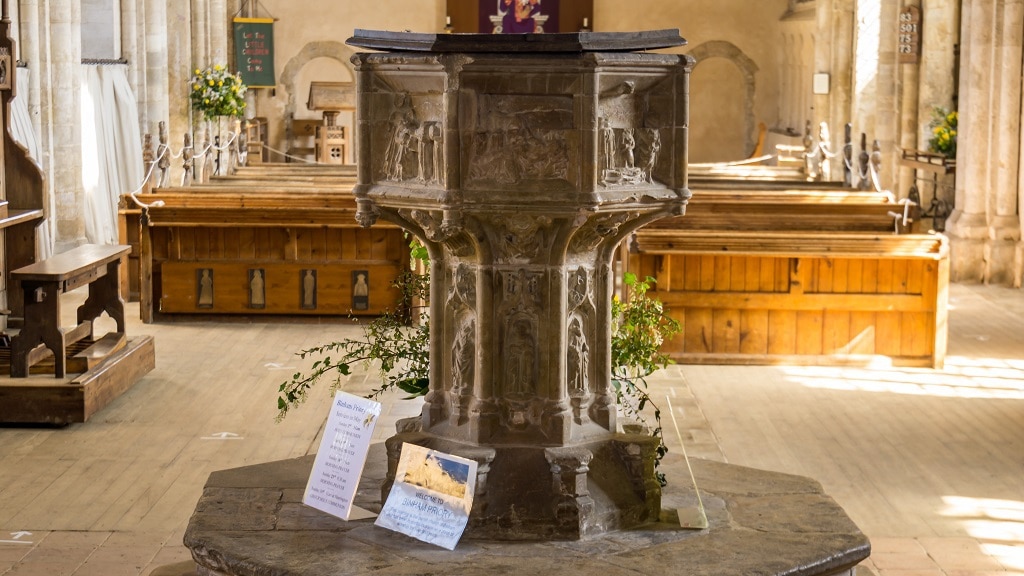
Painting of The Crucifixion by Leslie Marr – It’s different than any other painting of the crucifixion I’ve seen and I loved it.
Artifacts discovered during excavations – Just to the right when you enter the church, there is a case of artifacts including a stylus, buckle, crucibles, and more.
Panels of Painted Glass – They have taken fragments of glass found around the site during excavations and turned it into artwork.
Priory Grounds
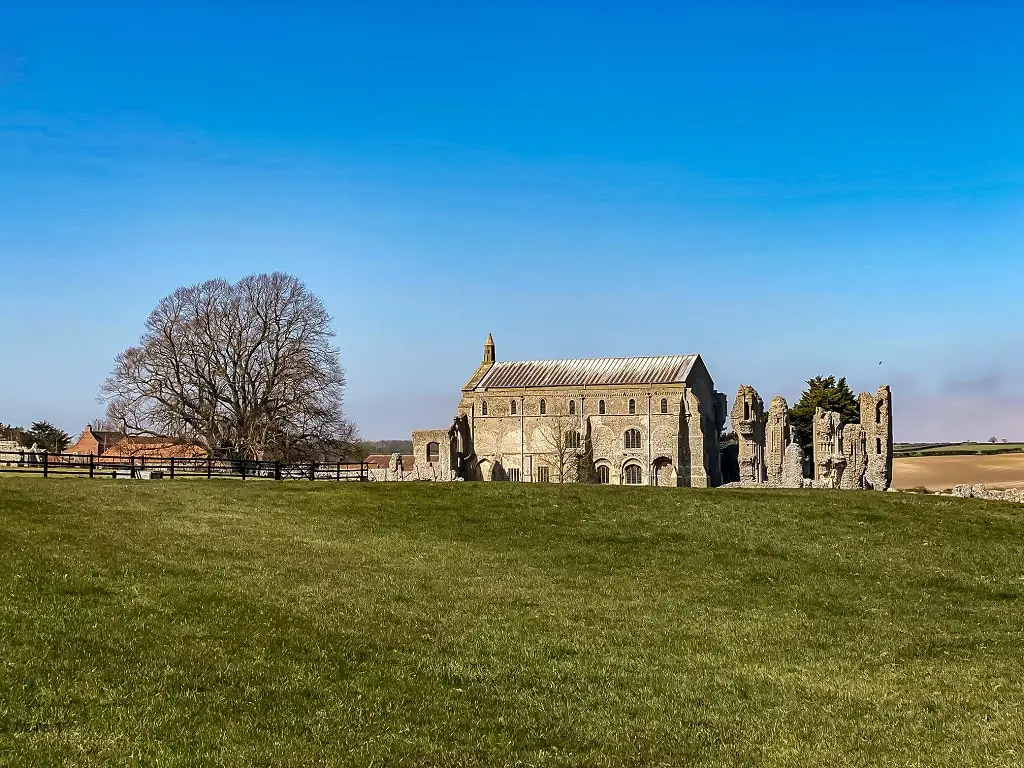
The Priory was much larger than the area of ruins you see today. There are earthworks that are the remains of other buildings. In the field in front of the cloisters, the earthworks are believed to be the remains of a large barn or granary. There is also a public footpath leading from the back of the church to the road (what is believed to be the precinct boundary) which goes by what is thought to be the site of the infirmary and monks’ cemetery.
Alexander de Langley, the prior of Wymondham, was buried in the monks’ cemetery. He became insane and was brought to Binham to live in solitary confinement and was buried in chains.
Binham Priory FAQs
You can visit the Binham Priory ruins any reasonable hour. Hours for the church vary but when we last visited it was open for private prayer from 11:00 to 15:00. Get the latest here.
It is free to visit the Binham Priory ruins and Parish Church. There is a donation box inside the church if you would like to contribute to the upkeep of this historic site. If you are looking for more free attractions, check out our list of the best things to do in Norfolk for free.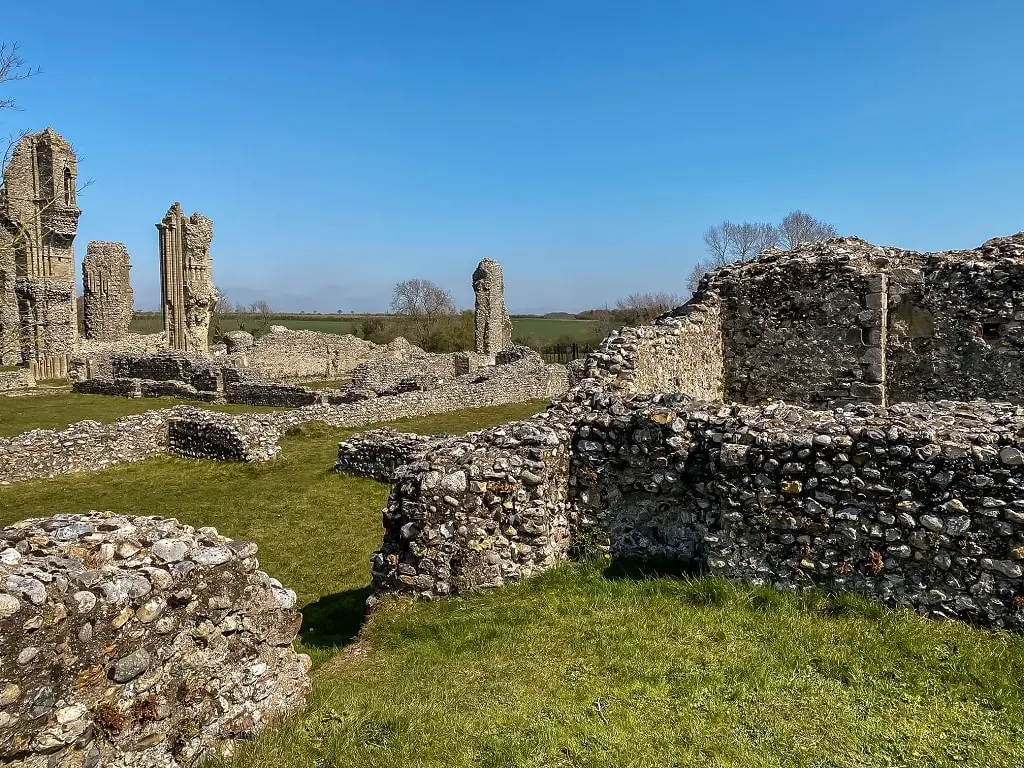
We spent about 90 minutes exploring the ruins and the church.
Yes. Kids will have fun exploring the ruins of the Priory and learning about the history. You will need to keep an eye on them as there are a few spots with steep drops. Get more ideas for things to do with kids in Norfolk.
Yes. It is believed there are the ghosts of a black monk and a fiddler in the tunnels near Binham Priory. There have been reports of seeing the black monk at night and hearing the fiddler’s music around midnight. Read more in our guide to the most haunted places in Norfolk.
The church has toilets inside, but that will not always be open. When we visited there was also a temporary toilet between the café and gatehouse.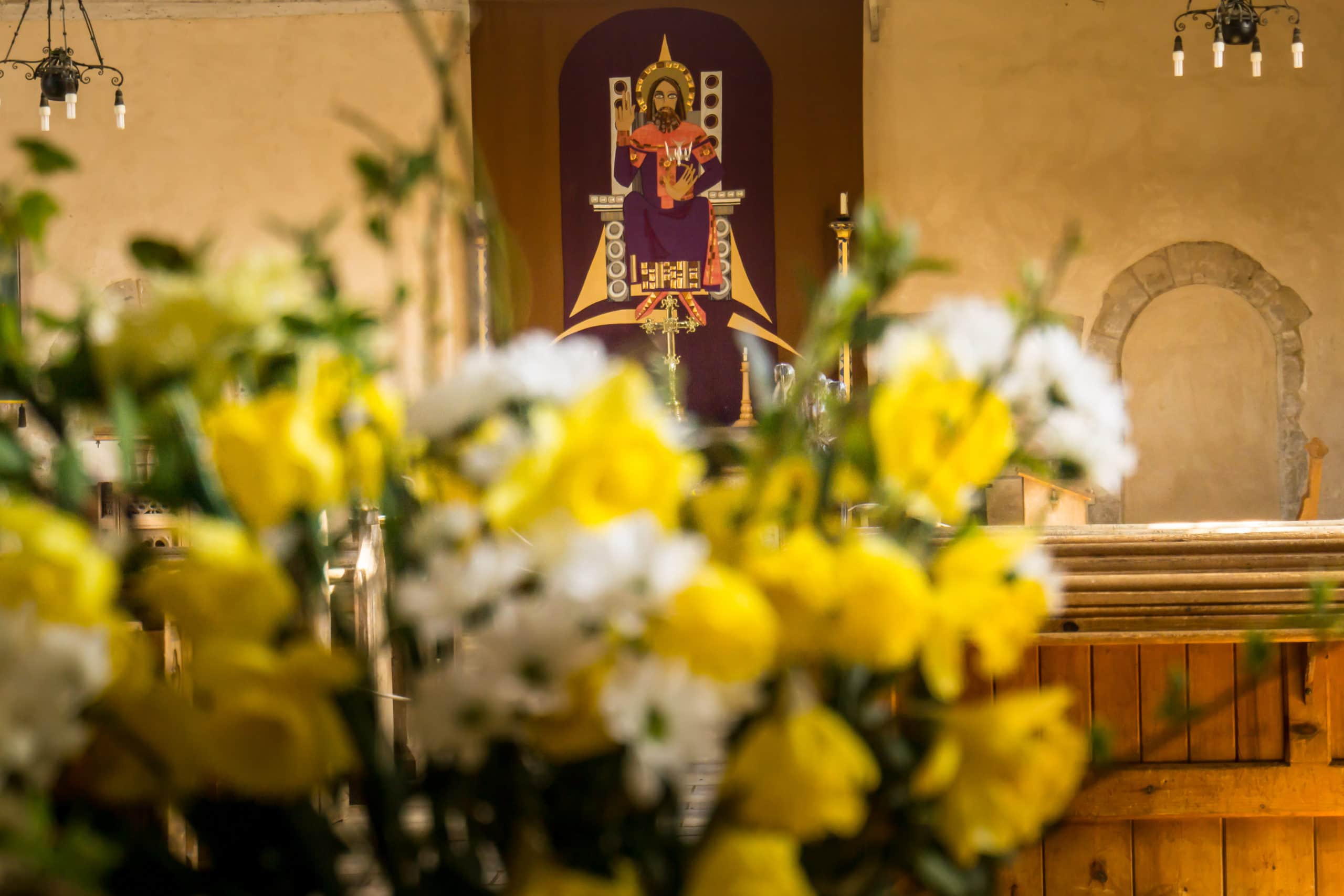
Dogs on leads are welcome to visit the Binham Priory ruins. Only assistance dogs are allowed inside the church. Please be sure to clean up after your dog.
Yes there is free parking in front of the church for about 10-12 cars. As you can imagine, this will fill up during the peak season and weekends, so go early if you can.
No. It is a Scheduled Monument.
The farm next door runs “The Little Dairy Shop.” It’s a self-serve store where you can grab cheeses, yoghurts, raw milk, jams, and more that are all made locally. You can also get a take-away coffee. There are no sandwiches, soups, or other main dishes.
The Chequers Pub is another option for food and drink just a short walk away. They have a kids menu.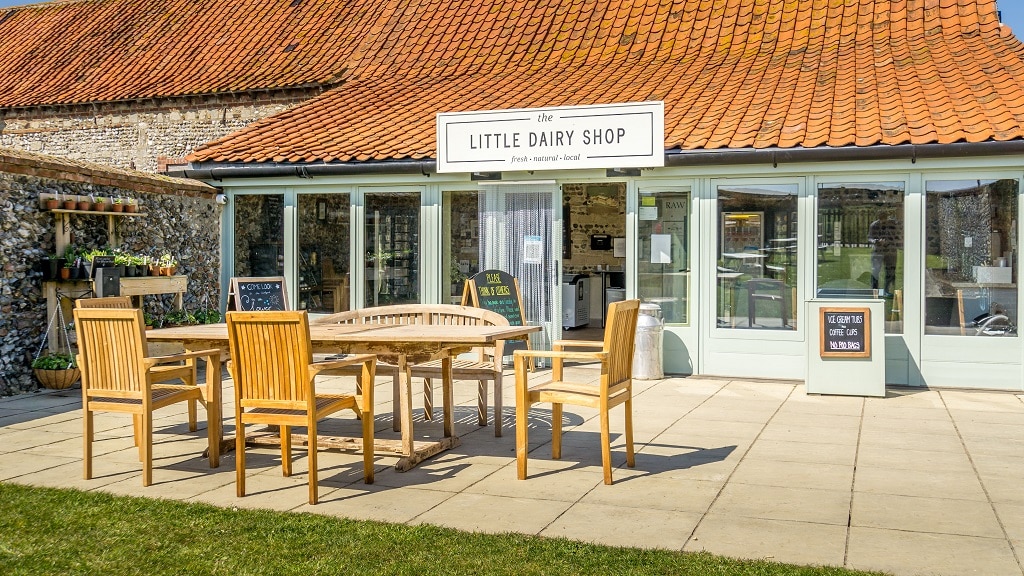
Yes. There are a few picnic tables near the cafe/shop. We also saw people with picnic blankets in the Cloister area.
It’s best to drive to Binham Priory which will take about an hour from Norwich. You can use “Binham Priory” in Google maps to get specific directions. It’s just on the edge of the Binham Village and it is sign-posted.
Note that public transportation to Binham Priory is difficult. The best option I found from Norwich required three different buses and took three hours.
More Things to Do Near Binham Priory
While you are in the area, there are a few other things you should see.
Warham Camp
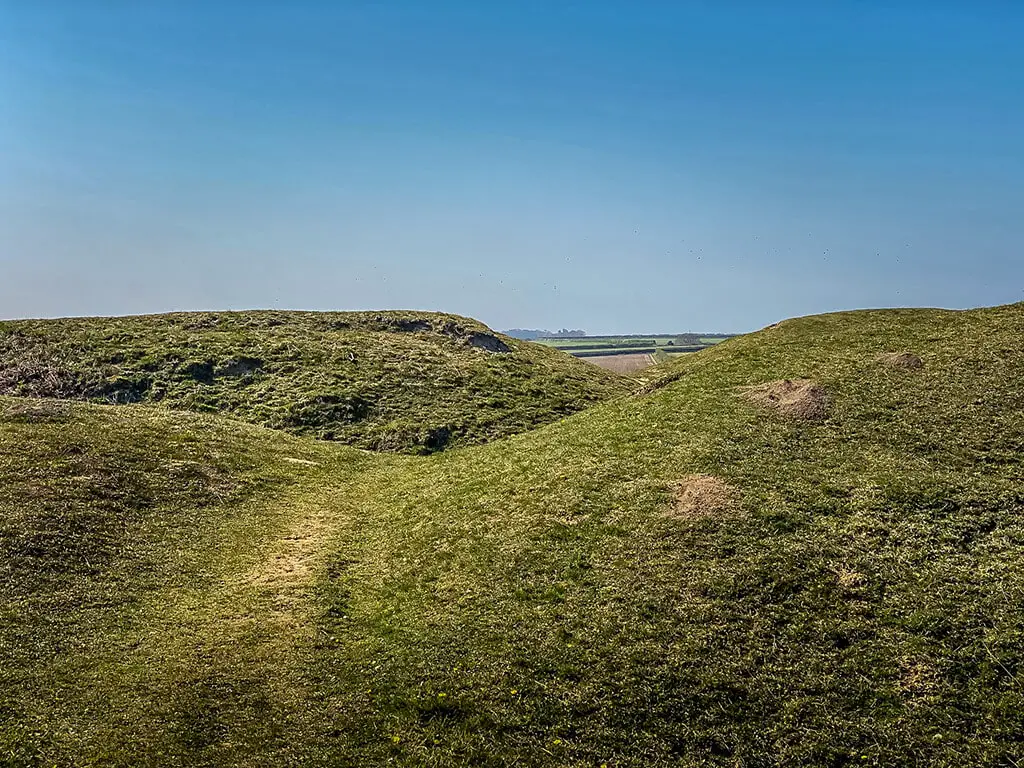
Warham Camp is an iron age hillfort, just a few miles away. It’s the best preserved one in Norfolk. Be sure to read our guide to the Warham Camp Hillfort to help plan your visit.
Hindringham Hall and Gardens
Hindringham Hall is a moated manor house straight out of a fairytale. It has a medieval moat, fishponds, a working walled vegetable garden, and a brick and flint Tudor Hall. The Hall is only open for tours a few days a year and the gardens are only open to twice a week from April through September.
Get more information here.
Blakeney Point
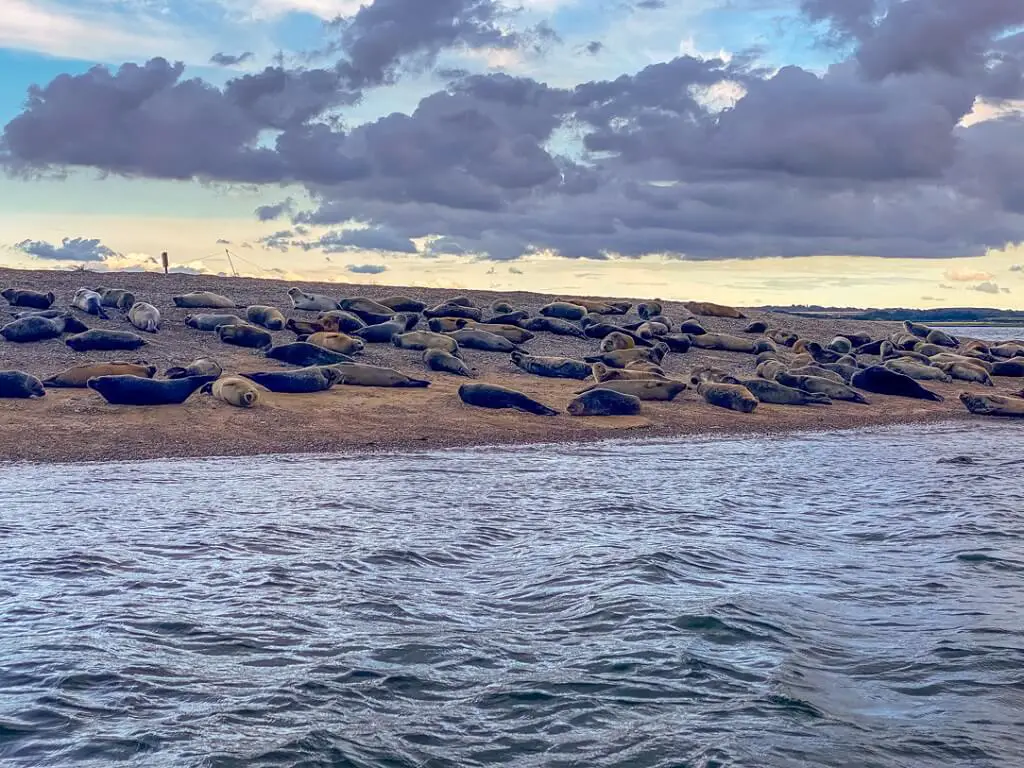
Blakeney Point is home to one of the largest seal colonies in the UK, but to see them you will need to take a boat trip from Morton Quay. It’s quite a special experience to be able to see these adorable animals in their natural environment.
Read more about seeing seals in Norfolk.
Wells-Next-The-Sea
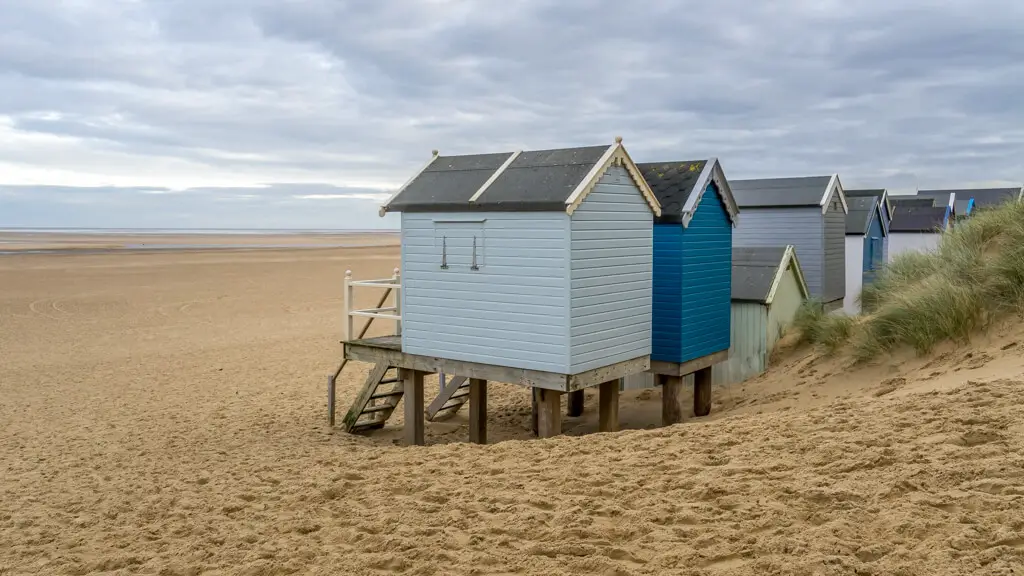
Wells is a charming seaside town, best known for its long row of beach huts on stilts on its huge sandy beach. Like Holkham, there is plenty of space on the sand when the tide is out. Wells does have calmer water too.
The town of Wells-Next-the-Sea is actually about a mile from the beach by the harbour. The quayside area has several historic buildings including the iconic granary building.
During the summer months, you can see the striking sculpture called The Lifeboat Horse in the harbour. There are boat and SUP tours if you want to see the area from the water.
Wells-Next-the-Sea is also a hotspot for the arts in North Norfolk. The town has several art galleries and the relatively new Wells Maltings, an arts, heritage and community centre inside a Grade-II listed Maltings building.
Read about more things to do in Wells-Next-The-Sea.
Disclosure: This post contains affiliate links. This means we will receive a small commission for some purchases made using links in our blog with no additional cost to you. Please be assured we would not promote any product unless we believe that our readers will also benefit. The commission does not influence the editorial content of this site.
